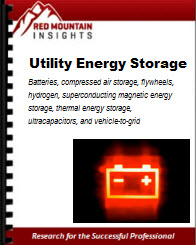True or false: solar and wind power are freely available and clean, and thus should always be stored when they generate more energy than the grid can use? It’s easy to assume that renewable energy should never be turned off, but scientists at Stanford have done the math to find the break-even point where storing energy is better than “wasting,” or curtailing, that energy, and their findings aren’t necessarily as you’d think.
Though curtailing energy production results in an immediate energy loss, avoiding that loss through energy storage also requires an investment of energy, either through manufacturing batteries or building infrastructure. However, not all storage is the same, nor are the energy demands of creating wind and solar farms equivalent. By expressing all the energy in equivalent terms, the team could compare the return of energy garnered from solar and wind with the energy stored in batteries, per unit of energy required to build either (expressed as EROI for return of energy, and ESOI for the storage of energy).
Because solar panels are more energetically expensive to produce than wind turbines, the EROI values differ by a factor of ten. When looking at various types of batteries, even more efficient flow batteries, all had much lower ESOI values than the geologic energy storage methods studied, which were compressed air energy storage and pumped hydroelectric storage.
Factoring in these differences, the study’s results show it’s currently always a better option to store solar energy because of the high energetic cost to recoup. However, the only storage options that are always better than curtailment of wind are geologic methods, with battery storage becoming better than curtailment depending on the fraction of energy being used in the grid instead of being stored or curtailed. In the graph below, you can read the ? in the bottom axis as representing that fraction. At the far right, if 100 percent of the energy is being curtailed or stored (i.e., none is going to the grid), then storing it is just barely a better option with any battery type. But at other rates it depends on the battery type.ll had much lower ESOI values than the geologic energy storage methods studied, which were compressed air energy storage and pumped hydroelectric storage.
It seems counter-intuitive that wind energy should be so cheap yet benefit in most cases from curtailment. But Michael Dale, one of the co-authors of the study, compared it to storing valuables in a safe. “You wouldn’t spend $100 on a safe to store a $10 watch,” he writes. In some situations it may even be preferable, in terms of energy expenditure, to build a new wind turbine rather than build storage for existing turbines.
The authors also make it plain that they’re condensing the question down to comparing one variable: the energetic trade-offs involved. But relying on economics alone avoids these considerations, and can even turn so-called green energy into the opposite. The authors calculated how much the life cycle of batteries would need to improve before becoming a viable option for wind – by a factor of two to 20, depending on the type of battery. But more importantly they also encourage the development of technologies that can use the otherwise curtailed energy in applications that aren’t harmed by being intermittent, such as systems to pump or purify water.
Sources: Stanford University, Royal Society of Chemistry


